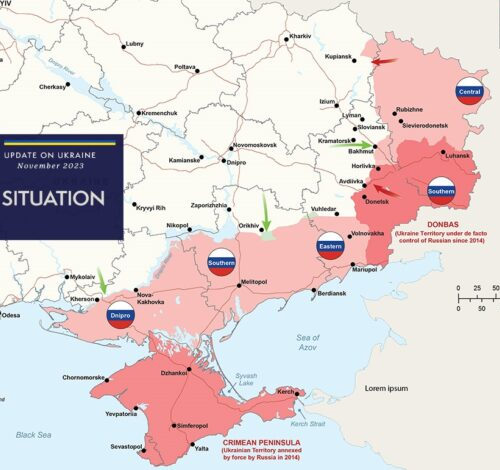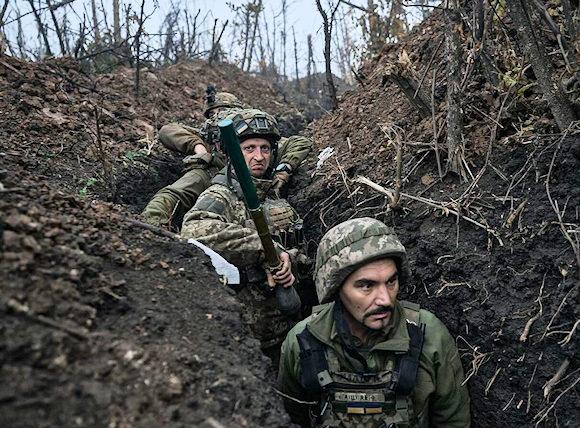The Ukrainian summer-autumn counteroffensive failed due to a multiple series of factors, both of a tactical military and "grand tactics" nature, and of a political-economic-industrial nature. In particular, as regards this second set of elements, the factors that weighed first of all were supply difficulties of weapons and ammunition for the Ukrainian Armed Forces, considering that Kyiv still has a defense industry at the "nascent" stage - with the exception of the particular branch of the design and industrialization of drones and electronic warfare - and that the European one is unable to supply the AFU with the speed and quantity that would be needed and that, especially in the kinetic phase of the counteroffensive, would be needed.
From a strictly military point of view, it must be noted that the Ukrainian counter-offensive was planned as a gigantic maneuvered operation which should have led, through a concentration of the greatest effort in the Surovikin line between Vasilivka and Robotyne, to the breakthrough of the Russian defenses, leading the Ukrainian armored forces and infantry to Tokmak and, from there, to Melitopol and, therefore, to the strategic objective of “forcing” the Crimean corridor.
Already in the first days of combat, also due to the unexpected resistance (with a certain shortsightedness) of the Russian entrenched camp, this original plan had been revised, with the Ukrainian commands forced to abandon the maneuver in favor of conducting a battle of friction along the entire front line. The “fire and maneuver” tactic, as the general of the Ukrainian General Staff, Oleksandr Tarnavsky, had summarized it, was abandoned almost immediately. A choice which, born as "provisional", in view of a rapid return to maneuvered actions, ended up, instead, characterizing the posture of the attacking army. At least in that phase, following the preliminary actions which had seen the Ukrainian troops advance a few hundred meters beyond the front line, the aim was to damage the Russian logistics chain to undermine the compactness of the defense system. Objective never fully achieved.
 The crux of the problem is that the Ukrainians tried to fight a Bewegungskrieg (maneuver warfare) where it was taking shape, also in consideration of the characteristics of the Surovikin line prepared by the Russians (and which were well known to the high command in Kyiv), a battle of depth in all respects. Soviet theorists such as Vladimir Kiriakovič Triandafillov, Georgij Samojlovič Isserson and Nikolai Efimovič Varfolomeev (who are well known both in Moscow and in the armies of the former provinces of the Soviet empire) had already identified the concepts of glubokij boj (battle in depth) e glubokaja operacija (in-depth operation), with the consequent predominance of "continuous fronts" and the impossibility of identifying a single "point of maximum effort", the Clausewitzian main emphasis.
The crux of the problem is that the Ukrainians tried to fight a Bewegungskrieg (maneuver warfare) where it was taking shape, also in consideration of the characteristics of the Surovikin line prepared by the Russians (and which were well known to the high command in Kyiv), a battle of depth in all respects. Soviet theorists such as Vladimir Kiriakovič Triandafillov, Georgij Samojlovič Isserson and Nikolai Efimovič Varfolomeev (who are well known both in Moscow and in the armies of the former provinces of the Soviet empire) had already identified the concepts of glubokij boj (battle in depth) e glubokaja operacija (in-depth operation), with the consequent predominance of "continuous fronts" and the impossibility of identifying a single "point of maximum effort", the Clausewitzian main emphasis.
On a broad front, rather than trying to create various breaches in the enemy's defensive system, the Ukrainians first identified a specific point on the front where they could attempt the breakthrough and then concentrated their efforts there, also encouraging intelligent use of the reserves by Russian. Instead of overloading the Russian logistics network, requiring Moscow commanders to direct reserves to multiple points on the front, the AFU persisted in the fighting around Robotyne, effectively remaining stuck there.
For the theory of glubokij boj, the moment of decision (decision) can no longer be achieved through the identification of a single point of maximum effort which, on a continuous front line, even more so if made up of trenches, where it is impossible to circumvent also due to the absorption capacity of offensive attacks by an elastic defense in depth, necessarily multiplies into numerous "offensive points" or, to use an improper term, "main emphasis tactical" whose conquest or defense does not guarantee the success of an operational cycle. Moreover, Clausewitz himself had already warned about the excessive extension of the front lines “is in conflict […] with all the requirements of a decisive battle”.
In the Ukrainian plan, the "breaking point" of the Russian defense system was identified a priori, without waiting for it to materialize in the face of the possible collapse of a specific sector of the Surovikin line. Objectively secondary fronts for the specific war plan of the counteroffensive, such as that of Donbass - where, paradoxically, the Ukrainian forces achieved the greatest successes - or that of Stepove-Novomaiorske, on the border between the Donetsk and Zaporizhzhia oblasts, which some analysts they had, instead, been identified as the true fulcrums of the counter-offensive effort, they actually played an exclusively "ancillary" role to the main operations, but it was an element easily understood by the Russians and revealed several times by the Ukrainians.
In the phase of stagnation following the resumption of operations, after the "operational pause" of the first weeks of the counteroffensive, even the Ukrainian "movement" military actions, victorious on the secondary fronts, had the function of fueling the "battle of attrition" ” on the main front.
This may seem like "school" reasoning, purely theoretical, disconnected from the harsh reality of the Ukrainian battlefield. But it is the theoretical basis of the concrete failure of the Ukrainian counter-offensive, the reasons for which are also being debated in Kyiv and which also pushed the commander in chief of the Ukrainian Armed Forces, General Valerij Zalužnyj, to write a document about that.
Moreover, as Domenico Bonamico wrote in 1880 in "First elements of maritime warfare", the tactical functions - and their characteristics - and "grand tactics" remain unchanged even in the face of renewed factors (such as the use of drones or electronic warfare in the case of the Russian-Ukrainian conflict) which could lead us to imagine who knows what transformations in the art of war.
The combination of drones and precision weapons is a useful support for operations conducted with classic weapons and equipment. The technological transition of conventional warfare increases (and not always) the lethality of armaments, but the tactical and strategic approach has not changed. This finding, supported by extensive literature on example historians and contemporaries, seemed so complex to a large part of international military and geopolitical analysts, who, just like some Western politicians, were struck by the “miracle” syndrome which would have determined the Russian defeat in the face of a Ukrainian plan recognized as incorrect in its premises.
Photo: X












